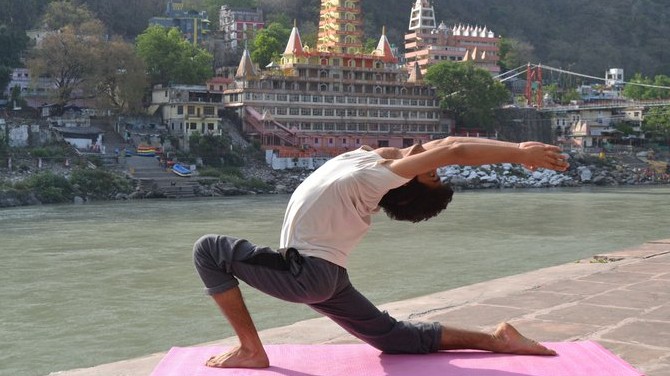Embarking on a 200-hour yoga teacher training (YTT) in Rishikesh is an exciting and transformative experience. Known as the “Yoga Capital of the World,” Rishikesh offers a unique environment that combines the natural beauty of the Himalayas, the sacred flow of the Ganges River, and an authentic atmosphere for learning yoga. This guide will walk you through everything you need to know about the 200-hour yoga teacher training course in Rishikesh, especially for beginners who are taking their first steps on the path of yoga teaching.
Why Choose Rishikesh for Yoga Teacher Training?
Rishikesh has been a spiritual hub for thousands of years, attracting yogis, seekers, and spiritual enthusiasts from across the globe. The city is renowned for its many ashrams, yoga schools, and teachers who carry on the ancient traditions of yoga. Some of the most respected yoga lineages and gurus have roots in Rishikesh, making it an ideal destination for a genuine experience.
What is a 200-Hour Yoga Teacher Training Program?
The 200 hour yoga teacher training in rishikesh is an introductory course designed to build a strong foundation in yoga. It is certified by the Yoga Alliance, which is a globally recognized organization for yoga certification. The program covers a variety of aspects, including physical postures (asanas), breathwork (pranayama), meditation, philosophy, anatomy, and teaching methodology.
Key Components of a 200-Hour YTT in Rishikesh
Asanas (Physical Postures):
The physical practice of yoga is often the first aspect that attracts beginners. The 200-hour YTT course covers foundational postures (asanas) from traditional Hatha and Vinyasa yoga styles. Students learn correct alignment, safe adjustments, and modifications, which are essential for teaching and personal practice.
Pranayama (Breathing Techniques):
Pranayama, or breath control, is a fundamental piece of yoga. The training program introduces students to basic pranayama techniques, such as Anulom Vilom (alternate nostril breathing), Kapalabhati (skull-shining breath), and Bhastrika (bellows breath). These practices help to control the mind, reduce stress, and increase mental clarity, which are crucial for both personal well-being and teaching.
Meditation and Mindfulness:
Meditation is a core part of the YTT curriculum. Students learn various forms of meditation, such as guided meditation, silent sitting, and mantra chanting, to develop a focused mind. The training emphasizes building a daily meditation practice to enhance self-awareness, which helps teachers guide others on their journey.
Yoga Philosophy:
Yoga philosophy introduces students to the ancient texts that form the foundation of yoga. The Yoga Sutras of Patanjali, the Bhagavad Gita, and other sacred texts are explored, offering insights into the ethical guidelines and spiritual practices of yoga. Understanding these principles helps beginners grasp the deeper meaning of yoga beyond just physical exercise.
Anatomy and Physiology:
Knowing the basics of human anatomy is crucial for safe practice and teaching. The YTT program covers anatomy and physiology as it relates to yoga, including the musculoskeletal, respiratory, and nervous systems. Understanding these concepts enables students to practice and teach yoga safely, reducing the risk of injury.
Teaching Methodology:
One of the main goals of the 200 hour yoga teacher training in rishikesh is to equip students with the skills to teach yoga confidently. Teaching methodology classes cover topics such as sequencing, alignment cues, class management, and adjusting poses. Beginners also have opportunities to practice teaching, often starting with their peers and gradually building up to teach a small group under supervision.
What’s in store During a 200-Hour YTT in Rishikesh
Yoga teacher training in Rishikesh is typically structured as a full-time, immersive program with a daily schedule that starts early and ends in the evening.
Morning Asana and Pranayama Practice: The day usually begins with an invigorating asana practice, followed by pranayama to energize the mind and body.
Breakfast: Meals are typically simple and vegetarian, in line with the yogic diet.
Philosophy and Anatomy Classes: Mid-morning sessions cover philosophy and anatomy, providing a theoretical understanding of yoga.
Lunch Break: A nutritious meal is served, giving students a chance to rest and reflect.
Teaching Methodology and Asana Lab: In the afternoon, students participate in asana labs and teaching methodology sessions where they practice adjustments, alignments, and sequencing.
Evening Meditation and Reflection: The day ends with meditation or reflection sessions to cultivate mindfulness and integrate the day’s learnings.
This rigorous schedule allows for complete immersion, helping beginners to experience yoga holistically and develop discipline and dedication.
Benefits of Completing a 200-Hour YTT as a Beginner
Deepen Personal Practice:
A 200-hour YTT provides the tools and knowledge to deepen your personal practice, understanding postures and breathwork in greater detail.
Cultivate Discipline and Routine:
The structured environment of a YTT helps instill discipline, a core aspect of yoga. Developing a daily routine of practice, study, and reflection can enhance both your yoga journey and personal life.
Gain Teaching Skills:
Even as a beginner, completing a YTT equips you with the fundamental skills to guide others. Whether you plan to teach professionally or simply share yoga with friends and family, you’ll be prepared to lead with confidence.
Join a Supportive Community:
A YTT program is an excellent way to meet like-minded individuals who share a passion for yoga. The connections made during this training often turn into lifelong friendships, support networks, and collaborative opportunities in the yoga community.
The most effective method to Pick the Right Yoga School in Rishikesh
When selecting a yoga school for your 200-hour YTT, consider factors like:
Accreditation: Ensure that the school is certified by the Yoga Alliance, which ensures that the curriculum meets international standards.
Experienced Instructors: Look for schools with experienced and well-reviewed teachers, as they play a significant role in guiding your learning.
Course Curriculum: Make sure the curriculum aligns with your interests and goals. Some schools emphasize different aspects of yoga, such as philosophy or anatomy, so choose one that fits your focus.




